Facts About Golden-shouldered parrot
The golden-shouldered parrot, also known as the alwal, is a rare and captivating bird native to the southern Cape York Peninsula in Queensland, Australia. Closely related to the red-rumped parrot, it is considered part of a superspecies that includes the hooded parrot of the Northern Territory and the seemingly extinct paradise parrot of Queensland and New South Wales.
The adult male golden-shouldered parrot is notable for its vibrant blue plumage and distinctive yellow shoulder patch, while females are adorned in greenish-yellow feathers. These birds possess a unique nesting habit, as they construct their nests within termite mounds. Their diet primarily comprises grass seeds, with a particular preference for firegrass.
During the breeding season, these parrots lay a clutch of 3-6 eggs inside termite mounds. The eggs are incubated for approximately 20 days. Interestingly, they maintain a symbiotic relationship with a specific moth species that helps keep their nests clean. Despite this fascinating interaction, the golden-shouldered parrot is classified as endangered, with an estimated population of only about 2,000 individuals. They face numerous threats, including predation, habitat loss due to alterations in traditional Aboriginal burning practices, and disturbances from feral animals.
To mitigate these threats, conservation efforts such as habitat restoration and captive breeding programs have been initiated to stabilize their population.
Caring for golden-shouldered parrots in captivity demands meticulous attention. They require heated nest boxes, a diet that prevents obesity, and appropriate housing to avoid aggression between pairs. Captive breeding programs are essential for maintaining a healthy gene pool and ensuring successful reproduction. Although they are scarce in captivity, devoted groups of breeders in Australia and around the world are vigorously working to promote the breeding and conservation of this exquisite species.
